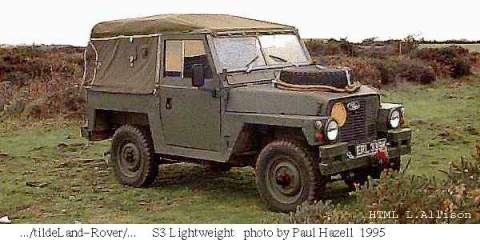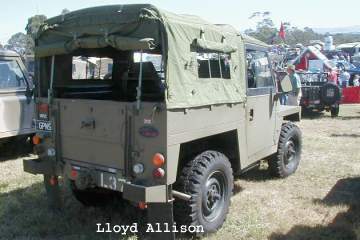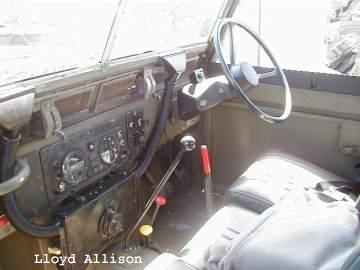Army Light-Weight Land-Rover
The light-weight was a Land-Rover specially lightened so that it could be easily lifted by helicopter. Much of the bodywork can be quickly removed for air-transport. Most came as soft-tops, a few as hard-tops; many of the former are converted to HT when in private hands.
Dates
- 1968: S2A Air-transportable `Light-Weight' or `half-ton' introduced.
- 1970: Headlights moved to wings.
- 1972: S3 version.
- 1976: Diesel engine offered.
- 1983: End of production.
History
Paul Hazell, p.hazell at worc.ac.uk, © 1995.
Rover tried several times in the sixties to develop Land Rovers specifically for military use recognising there strength in this market. However the only vehicle that survived beyond the experimental stage was the 1/2 ton Lightweight. The prototype was drawn up in about 1965 to meet a specific requirement for an air-portable vehicle for the British Armed Forces. The British Military General Staff stipulated that the light 4x4 truck had to be narrow enough to fit two-abreast into the Argosy transport aircraft, then in service, and weigh in at about 1,134 kgs (2,500lbs) unladen weight to be carried under the Wessex, the current "run about" helicopter of the armed forces.
The prototype vehicle was initially based on the general service version of the 1/4 ton (which refers to its payload, not its weight) 88" Series IIA. The long wheel base (109") was also considered due to its improved load area, but there was no way that it could be made light enough.
To get the Land Rover to meet the weight target the 1/4 ton vehicle was completely stripped then rebuilding with only the items deemed essential to make the vehicle mobile being added. Therefore items such as doors, windscreen, some body panels, spare wheel, hood and the rear seats were not needed. The vehicle finally ended up as a chassis equipped with very a simple angular body with a narrow bulkhead (fire wall) and axles to fit in the Argosy. The body's aesthetic being determined by the need to cover the wheels and house the side lights/indicators with the head lights being placed in the grill Leaving a very stark looking vehicle.
The hood, spare wheel, body sides, bumper etc. could be removed quickly in the field and flown on as a separate package, after the vehicle had been airlifted to the scene of operations. As it turned out this ability to be stripped down, the very thing that dictated its appearance, was rarely used in practice , because by the time the Lightweight came into service there were new more powerful helicopters available to transport it.
Having been shown in prototype form in 1966, the project moved on to the production phase in 1968. Very little changed from the prototype, a new style front grill was added (similar to the SII general service) and a narrower bumper was designed and the vehicle was up rated to 1/2 a ton payload. It was available from day one as either a General Service model with a 12-volt electrical system or as a 24-volt FFR (fitted for radio), fully suppressed version. Examples began to enter service in 1969. All of the first batch shared the running gear with the civilian SIIA, all had petrol engines and were delivered to all three wings of the British Armed Forces with the vast majority going to the army. They were officially referred to as the "Land Rover Series IIA Truck, Utility, 1/2 ton, 4x4" or simply as the "Rover 1" In all 2,989 series IIAs were built.
Rover didn't start to build the Series III lightweight until 1972 when it had cleared its outstanding SII orders for the MOD. It was at this point Rover began to offer the Lightweight to overseas buyers. And in time orders were received from Belgium, Brunei, Guyana, Holland, Hong Kong, Indonesia, Jamaica, Libya, Saudi Arabia and the Sudan. The differences between the series III and the series II were the same as those found in the civilian version i.e. the headlights were moved to the wings (actually this had already happened in 1970 to the later SIIs) and the gearbox now had synchromesh on all forward gears rather than just 3rd and 4th.

Most Lightweights had the 2.25L petrol engine, however the British Armed Forces did take some with diesels for specialist uses. In fact all those supplied to the Netherlands were Diesel powered. Bodies were generally soft top but hard top versions could be ordered. 12,334 Series III were built up to 1980. Records after that year are patchy but it is reckoned that about 18,000 Lightweights were built up until production stopped somewhere between 1983 & 1985. The Lightweight was replaced by the Land Rover 90, however some still soldier on in specialist roles and many still serve at weekends with the Territorial Army. Some people think it's an ugly little thing, personally I think it has a certain beauty in its functional appearance.

SIII

Note Smiths Heater
Special Versions of the Lightweight
Several "special" Lightweights were produced over the years.
Emergency ambulance
This version was designed as an emergency forward area ambulance. It was capable of carrying two stretcher cases by the addition of a canvas "box" protruding from the rear.
Anti-tank vehicle
This was a special conversion by Marshall of Cambridge Ltd to meet a requirement from the Sudan government. They came standard with a 106mm recoilless light anti-tank gun M40A1 and mount M79, Seats for the crew, storage for ammo, blast shields to protect the bonnet when firing forwards, split windscreen, a pick and a shovel. Some versions were built minus a bonnet mounted spare wheel to improve visibility. Apparently some saw action in the Gulf war. A similar specification is now offered on the Defender 90.
Royal Marine deep wading Lightweight
Some Lightweights were specially prepared for deep wading between landing craft and the beach by the Royal Marines own workshops (as were some 109"s, 110s etc.). To protect against salt water special anti corrosion treatment was added as well as adaptations to the engine fan, air intake, fuel tank, gearbox, transfer box, battery, and most importantly the electrical systems. The vehicles had a very reduced life span due to the harsh environment they had to work in (I wouldn't buy one second hand!)
VPK Lightweight
Some Lightweights stationed in Northern Ireland received the a VPK (vehicle protection kit) of applique armour to protect against blast bombs, rocks etc. Cheerful stuff. This was done by the Army in its own work shops. Only one example survives in civilian hands.
The "Big Lightweight" or "Bonnettea" 3/4 ton
This was a private venture by Land Rover to produce an air-portable vehicle designed for pulling power-driven trailers. It was similar in style to the 1/2ton and used some components from it. It was powered by Rovers 2.6L 6cyl petrol engine. It only reached prototype stage in 1965 with just 3 being produced.
Ligero/88" Militar
This was the Santana version of the lightweight (available from 1970). The military version, known as the 88" Militar was produced for the Spanish army as well as Morocco and Egypt. Unlike the British version it was also available as a civilian fun buggy - the Ligero. The vehicle was considerably heavier than the British Lightweight.
Other interesting Lightweights
There were also other "specialist" lightweights, such as the small fleet of bronze green vehicles run by the Honourable Artillery Company in London.
These vehicles are decked out with white wheel covers, white seats, white hubs and chrome bumpers. They are open top but with the screen up. They are used for towing 25-pounder guns which are used in ceremonial salutes. I saw some recently ('95) on British TV as part of the Lord Mayor of London's parade - very fancy.
There were also other specialist Lightweights but they were all mechanically basically the same as the standard general service vehicle.